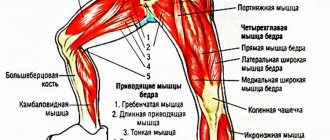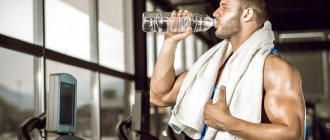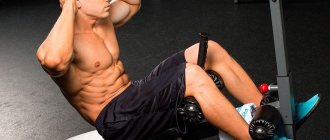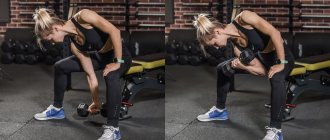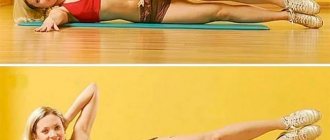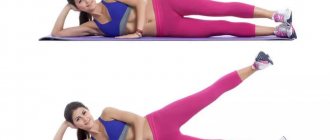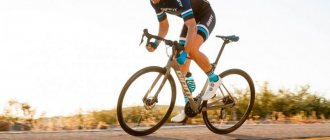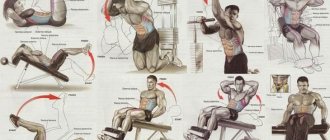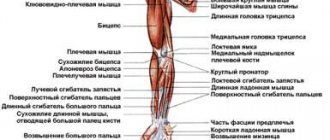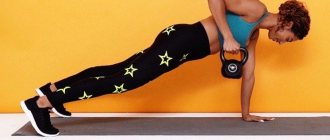The chair can become a universal exercise machine: it adds zest to cardio classes, yoga practice, and ballet lessons. The chair can also play a special role in Pilates classes. “The main task of Pilates is to teach a person to move the body, different joints and form the correct principle of movement,” explains Anastasia Yurkova , fitness manager of the X-Fit “Monarch” and X-Fit “Flotskaya” clubs, personal trainer of the group programs of the federal network X-Fit fitness clubs. “Therefore, in some positions, in order to teach a person to work in isolation, for example, with the thoracic region, it is necessary to fix the lower back. The chair allows you to do this.”
This “simulator” also helps to complicate classic Pilates exercises. “Lying on the floor, performing leg raises, planks, and V-stabilization is noticeably easier than on a chair. In the latter case, our plane of support decreases; we have to simultaneously support both the upper body and legs. We use more muscles,” adds Anastasia Yurkova.
We asked Anastasia to compose and show us a set of the most effective Pilates exercises with a chair.
Shoulder bridge
Lie on the floor, place your feet on a chair so that the angle of your knees is approximately 90 degrees. Take a neutral body position (we wrote how to do this here), with your arms along your body, palms down. As you exhale, gently lift your pelvis, twisting your lumbar spine and rounding your thoracic spine. Lock yourself at the top, maintaining one straight line from your knees to your shoulder blades. Leaning on your shoulder blades and shoulders, keep your buttocks and stomach tense. Inhaling, also smoothly lower yourself to the starting position, starting the movement from the thoracic spine. Perform 8-12 repetitions of the exercise.
Charging in the office (option No. 2)
The second version of the complex, like the first, is aimed at reducing hypertonicity of the back muscles, relieving fatigue from the arms and neck, activating blood circulation and lymph flow to improve well-being in the workplace.
Neck bends
Sit on a chair, keep your back straight, put your hands on your belt or on your knees. Tilt your neck to the right, then forward and to the left, without making sudden movements. If you feel pain and stiffness, then reduce the range of motion. Do not throw your head back, but when bending forward, stretch the back of your neck. A simple exercise for exercise in the office will remove tension from the cervical spine, provide gentle stretching of the trapezius muscle of the back and improve cerebral circulation.
How much to do: 18-20 inclinations in total.
Rotations in the shoulder joints
Continue to exercise in your office chair, but now extend your arms down to your sides. Lower your shoulders, relaxing your trapezius muscles. Now perform rotational movements in the shoulder joints, first forward, then back until the shoulder blades are brought together at the extreme point. Move at a slow pace to relax your muscles and relieve tension in your shoulder girdle. Such exercises at the workplace will relieve fatigue from the arms and neck, relieve stress on the upper back and maintain the health of the shoulder joints.
How much to perform: 8-10 forward rotations, then 8-10 backward rotations.
Sipping
Sitting on a chair, press your feet to the floor, raise your arms up and clasp your palms together, and then turn them outward, stretching the muscles of your forearms. As you exhale, bend your shoulders forward, rounding your back, and as you inhale, straighten up almost to the point of your shoulder blades. Try to feel the stretch in the latissimus dorsi muscles and the stretch in the thoracic spine. Stretching is the best natural exercise for back health, as it stretches the spine, stretches the muscles of the back and neck, reducing hypertonicity.
How many to perform: 13-15 repetitions.
Side twists
Sit on a chair with a straight back, knees bent at right angles, feet pressed to the floor. Place your arms horizontally in front of you, palms together. Rotate to the left while twisting your body, pause for a moment, and then rotate to the right while twisting the other way. Twists in yoga are considered the most useful exercises for the spine, as they return the discs to their normal position, gently stretch the back muscles, relieving tension, and also relieve pain in the lower back and neck.
How much to perform: 12-14 turns in total.
Lock behind your back
Sit on the edge of a chair, keeping your back straight. Place your hands behind your back and place your palms facing each other, as if in a prayer gesture. Hold the pose, trying to bring your shoulder blades together. If it is difficult, then perform a modified version of the pose, to do this, place your forearms on top of each other behind your back. Hold your back for exactly the specified amount of time. Exercise for office workers improves posture, returns the natural position of the spine and neck, and also has a meditative effect on the nervous system.
How long to perform: 20-30 seconds in two approaches.
Raising hands
When sitting on a chair, make sure there is enough space on the sides to spread your arms. Straighten your back, press your feet to the floor and straighten your arms in front of you, bringing your palms together. Spread your arms to the sides with your palms facing forward, bringing your shoulder blades together at the extreme point. Perform the exercise for exercise in the office slowly, fixating at the extreme point for the best effect. The exercise helps maintain correct posture, stretches the pectoral muscles and improves the mobility of the thoracic spine, eliminating muscle tension in this area.
How much to perform: 13-15 dilutions.
Leg straightening
Move the chair some distance from the table, and then sit on it, bending your knees at right angles, placing your hands on your hips. Straighten one leg until it is parallel to the floor, feeling a gentle stretch in the hamstrings. To enhance the effect, you can slightly pull the sock towards you. Repeat the exercise for the other leg. A light leg warm-up activates blood circulation and lymph flow in the lower body, preventing swelling, numbness and other unpleasant consequences of sedentary work.
How much to do: 12-14 lifts in total.
Walking in place
Sitting on a chair, move a little away from the table, bend your arms at the elbows and press them to your body, pointing your forearms forward. Clench your palms into fists, as if running. Lift your right foot off the floor and lift your knee up, while simultaneously moving your left arm forward. Come back, and then immediately repeat the movement with the other arm and leg. “Walk” in this manner for the specified amount of time, trying to maintain an even pace. Simple exercise in the office will help you warm up without leaving your chair by activating blood circulation throughout the body
How much to do: 18-20 knee raises in total.
Rotating brushes
Sit comfortably on a chair, stretch your arms out to the sides, palms up. From this position, rotate your wrists clockwise and then counterclockwise. Do not rush, as you may injure your wrist. The exercise is especially useful when working at the keyboard for a long time, as it helps relieve tension from the palms and wrist joints, and when performed regularly, prevents pain from overstraining the joints.
How much to perform: 8-10 forward rotations, then 8-10 backward rotations.
Tilt to the knees
Sitting on a chair, bend your knees at a right angle, press your feet to the floor. Lower your arms freely along your body. Bend over to your knees, trying to lie on your thighs with your stomach and chest. Lower your head down, stretching the muscles at the back of your neck. A simple static exercise for office workers stretches the spine, provides gentle stretching to the neck muscles, relieves tension from the lower back, and helps get rid of tension and pain in the back.
How long to do: 30-40 seconds for thorough relaxation.
For morning exercises, see also:
- Morning exercises fully standing without a mat: 20 exercises
- Active morning exercises for losing weight in the stomach: 20 exercises
- Exercises for the back while standing: prevention of scoliosis and osteochondrosis
Raising the leg from the “Extended bridge” position
Lying on your back, place your feet on the seat so that your legs are straight. Lift your pelvis off the floor, resting only on your feet and shoulder blades. Working the muscles of your buttocks and abs, stretch behind your feet and the top of your head. While holding this position, as you exhale, lift your legs up one at a time. Perform 8-12 movements with each leg.
Want to learn even more chair exercises? Visit our video library and turn on the Pilates lessons. Morning" with Leonid Zaitsev.
Reverse push-ups
The body weight is supported on the arms, which pumps up the shoulders and triceps well (Photo: r2-item.ru)
Exercise for the triceps of the arms. Can be performed with legs bent (easier) or with legs extended. How to do:
- Sit with your back to the chair.
- Stretch your arms back and rest your palms on the edge of the chair.
- Straighten your elbows and lift yourself up so that your feet rest on the floor and your thighs are parallel to the floor.
- As you inhale, bend your arms and lower your buttocks almost to the floor.
- As you exhale, return to the original position.
Keep your back straight and look ahead. Maintain one position as you perform. Only your hands should move.
To increase the load, extend one leg forward and do push-ups with emphasis on one foot.
How to choose the right workout chair
The main criterion when choosing a future simulator is reliability and stability. Therefore, you should not take a wobbly stool or a chair with a poorly secured seat. For the same reasons, we ignore the chair on wheels.
Another important point is the quality of the coating. The best option would be a chair with thick upholstery made of leatherette or other durable materials that will create reliable support for the arms and legs and will not tear from strong mechanical stress. However, an ordinary wooden stool with a well-polished surface will do.
Considering the specifics of some exercises, it is better to take two chairs at once for training: with a backrest and a stool. The height of the improvised exercise machine should ideally correspond to the level of your knee.
Personal experience: 10 exercises to pump up your butt while sitting at home
The text was written by our reader Natalya Kuzmich, and it turned out to be so good that we decided to publish it.
The healthy lifestyle trend is only gaining momentum every year. And there is nothing wrong with this, because each of us wants to be the most beautiful.
Natalya Kuzmich:
- So, look at the photo below. On the left is an ordinary woman, a housewife, a young mother who does not have time for constant training in the gym. On the right is the same ordinary woman, who still has a small child and a household in her arms, but she has found time for herself.
I didn’t like the way my body looked after giving birth, how my stomach bulged out, and the “lugs” on my hips and cellulite made it difficult to wear fashionable jeans and shorts. I started training at home, from scratch, having never exercised before, and six months later I discovered that my figure after giving birth can become stronger than it was before.
And here are the most effective exercises that will help you tone your entire body and that you can do at home with a minimum of equipment.
Manufacturing materials
Metal and wood are used to produce orthopedic kneeling chairs. The use of the former in the design allows increasing reliability, stability, and service life. Thanks to this, the product becomes universal and the adjustment possibilities expand. The steel base is chrome plated, painted with special paints or treated with Teflon coating.
For wooden models, solid oak, beech or multi-layer plywood are used. For home use, as a rule, these products are chosen because they are easier to fit into the interior, and in addition, such products weigh less. But if you need a chair that will retain its properties for as long as possible, then it is better to give preference to models with a steel frame.
Metal
Tree
Different materials are used as filling for knee pads and backrests. The most popular are foam rubber and latex. The first material is flexible, hypoallergenic, inexpensive, and lasts about five years. Latex is more elastic and porous. Thanks to the antistatic effect, dust accumulates less on it. It retains its qualities for up to ten years.
The surface of the chair is upholstered in fabric, leather and its substitute; there are also models with replaceable covers. Textiles allow air to pass through well, but if they get dirty, they are difficult to clean. The leather repels water and dust and is durable, but such models are more expensive. Products made from substitutes are cheaper, but they are not as wear-resistant. An excellent option is chairs with replaceable covers; they are easier to fit into the interior. In addition, they are much easier to care for.
Replacement cover
Fabric
Leather
Kneeling chair with backrest - pros and cons
You can purchase a posture corrector not only according to a doctor’s indications, but also for prevention – especially if you spend a lot of time in a sitting position. Judging by the reviews of orthopedists, the knee chair has the following advantages:
- Versatility. The design can be used at any age. The main thing is to choose a design in accordance with the height and build of the user.
- Operational safety. Unlike operations and other interventions, which have a lot of contraindications and can further harm health, the product will definitely not cause any harm.
- Possibility of use during pregnancy. Pregnant women often complain of lower back pain. Using an adjustable kneeling chair can help eliminate discomfort.
The orthopedic product has one drawback - there is a high probability that in the first days of using the design you will experience discomfort. This is normal, because it takes time for the body to adapt to an anatomically correct fit. In addition, a number of contraindications should be taken into account. Orthopedic doctors do not recommend using a knee chair immediately after a back injury, as well as for people suffering from scoliosis in the third stage.
In what cases do experts recommend a posture corrector? An orthopedic design will be your salvation for osteochondrosis, osteoporosis, and herniated intervertebral discs. In reviews of knee chairs, many doctors note that the use of the product during the rehabilitation period after fractures and injuries reduces the likelihood of complications.
How to pump up your butt at home with exercises
Simple and effective exercises to pump up your butt at home. 2 complexes for increasing the volume of the gluteal muscle with complication options for physically fit people.
The buttocks are considered one of the most problematic areas for most women and girls. A sedentary lifestyle, sedentary work and passive rest sooner or later lead to a decrease in the volume of the gluteal muscles and loss of their tone. Therefore, in order to have beautiful seductive forms, the fair sex must constantly work on their body. And it is recommended to start with home workouts. Simple exercises to pump up your butt, listed in our article, will help you get rid of figure problems in just 1-2 months.
General recommendations for performing the complex
Despite the fact that all the exercises from the weight loss complex will be performed with a chair, you will definitely not be able to sit quietly on it. To achieve the desired results, you will need to make every effort and burn as many calories as possible in a short time. The complex can be performed at any convenient time of the day, but it is still advisable to do it in the morning.
Experts give the following recommendations for such training:
- A warm-up is definitely needed to help avoid injury and discomfort during and after the complex. The concept of warm-up includes squats and jumps, rotational movements of the upper/lower limbs, head and torso, swinging the legs. After a general warm-up, you need to perform several stretching exercises.
- Throughout the entire workout, breathing should be correct - inhale through the nose, exhale through the mouth. This will ensure that the body receives the required amount of oxygen, which will “start” the process of accelerating metabolism. It is strictly forbidden to hold your breath even for 1-2 seconds - this can lead to unpleasant health consequences - for example, a sudden increase in blood pressure.
- During exercises, the abdominal muscles should be in constant tension. By the end of the training, both they and other muscle fibers will ache, there may even be a burning sensation - this is normal and confirms the correctness of the training.
Even if the desire to lose weight is too great, there is no need to work hard during training. All exercises are performed in a calm rhythm, without jerks or crazy speeds. It is required to perform the maximum possible number of repetitions of each movement, and if all this is easy, then you can use weights for the legs, thereby increasing the overall load.
We recommend reading about stretching for weight loss. From the article you will learn about the benefits of stretching, stretching exercises at home for the hips, abdomen, legs and back. And here is more information about static exercises for weight loss.
Literature
- Astashenko O.I. Exercises for weight loss. 15 minutes a day. − M.: Vector, 2010. − 144 p.
- Vella M. Atlas of anatomy for strength exercises and fitness. – M.: AST, 2007. – 247 p.
- Gortsev G.V. Nothing superfluous. Aerobics. Fitness. Shaping. − M.: Phoenix, 2004. − 256 p.
- Greenfil M. The figure of your dreams. − M.: Eksmo, 2003. − 240 p.
- Grishina Yu.I. Find your program. Fitness at home every day. – M.: Phoenix, 2011. – 256 p.
- Dontsov A. Body designer. Strength and fitness training. – M.: Peter, 2015. – 854 p.
- Campbell A. The Best Strength Exercises and Workout Plans for Women. – M.: Potpourri, 2014. – 200 p.
- Livingston V. Slim figure without effort and expense. − M.: Tsentrpoligraf, 2002. − 160 p.
- The best from Men's Health. Training without weights / Keith D. – M.: Potpourri, 2009. – 96 p.
- Pushkin V. A. Gymnastics in the office. − M.: Eksmo, 2011. − 511 p.
- Turchinsky V. E. Fitness for women. − M.: AST, 2010. − 542 p.
- Childers G. Get a great figure in 15 minutes a day. − M.: Potpourri, 2012. − 532 p.
Author: Korolev E. S.
Reviewer: reflexologist Kurus A. N.
